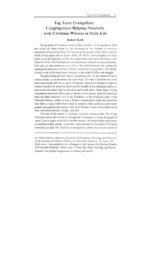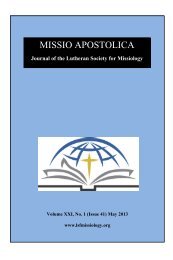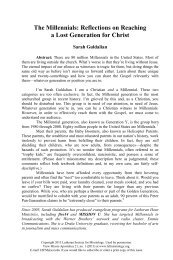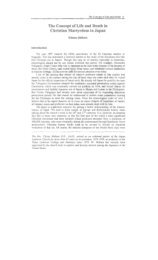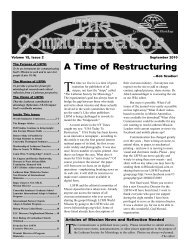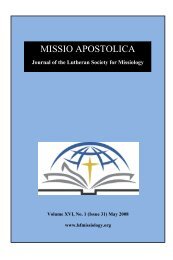The Beginnings of LCMS Work in India - Lutheran Society for ...
The Beginnings of LCMS Work in India - Lutheran Society for ...
The Beginnings of LCMS Work in India - Lutheran Society for ...
Create successful ePaper yourself
Turn your PDF publications into a flip-book with our unique Google optimized e-Paper software.
<strong>The</strong> <strong>Beg<strong>in</strong>n<strong>in</strong>gs</strong> <strong>of</strong> <strong>LCMS</strong> <strong>Work</strong> <strong>in</strong> <strong>India</strong><br />
Paul Heerboth<br />
At the very first Convention <strong>of</strong> the Missouri Synod <strong>in</strong> April 1847 a<br />
committee on missions was established. <strong>The</strong> policies <strong>of</strong> that committee<br />
emphasized mission to the heathen-"Heidenmission." However, because <strong>of</strong> the<br />
<strong>in</strong>flux <strong>of</strong> German immigrants, the founders <strong>of</strong> the Synod were overwhelmed:<br />
"On their isolated farms and <strong>in</strong> their self-conta<strong>in</strong>ed ethnic settlements some<br />
<strong>of</strong> them (immigrants) <strong>for</strong>got their God. <strong>The</strong> lapsed and the <strong>in</strong>different and<br />
the neglected had to be reclaimed by the spiritual ones, those devoted to<br />
their God, to the Gospel, and to their <strong>Lutheran</strong> Church. <strong>The</strong> founders <strong>of</strong> the<br />
Missouri Synod were keenly aware <strong>of</strong> this mission."'<br />
As we look back on how this challenge was met, we thank and praise God<br />
<strong>for</strong> the <strong>in</strong>fluence <strong>of</strong> Wilhelm Loehe and the Sendl<strong>in</strong>ge who were sent by him to<br />
America. With<strong>in</strong> the space <strong>of</strong> ten years Loehe had sent more than eighty<br />
workers: pastors, candidates <strong>of</strong> theology, "emergency men" (Nothelfer), students<br />
<strong>of</strong> theology, and teachers to America. <strong>The</strong>y contributed much to the missionary<br />
zeal <strong>of</strong> the Missouri Synod, and yet <strong>for</strong>ty-eight years elapsed be<strong>for</strong>e the Synod<br />
began its first <strong>for</strong>eign mission work, <strong>India</strong>, <strong>in</strong> 1895.<br />
<strong>The</strong> need <strong>for</strong> the Missouri Synod to have its own <strong>for</strong>eign mission endeavor<br />
was felt more keenly when <strong>in</strong> 1876 the Synod, because <strong>of</strong> doctr<strong>in</strong>al differences,<br />
discont<strong>in</strong>ued its support <strong>for</strong> the Leipzig Mission and likewise <strong>in</strong> 1879 <strong>for</strong> the<br />
Hermannsburg Mission. In the Convention <strong>of</strong> 1887 the Synod passed a<br />
significant resolution:<br />
RESOLVED, That the Synod empower the Board <strong>of</strong> Foreign Missions to<br />
take the <strong>in</strong>troductory steps toward the open<strong>in</strong>g <strong>of</strong> heathen missions also<br />
beyond our own country on behalf <strong>of</strong> Syn~d.~<br />
Paul Heerboth is Director <strong>for</strong> Adm<strong>in</strong>istration <strong>for</strong> the Board <strong>for</strong> Mission Services <strong>of</strong> the<br />
<strong>Lutheran</strong> Church-Missouri Synod and is Associate Editor <strong>of</strong> Missio Apostolica.<br />
'Carl S. Meyer, Mov<strong>in</strong>g Frontiers (St. Louis: Concordia Publish<strong>in</strong>g House,<br />
1964), p. 194.<br />
*Proceed<strong>in</strong>gs, 5th Delegate Synod, Fort Wayne, IN, 1887, pp. 63ff.<br />
(Synodical Bericht ... Funjle Delegaten Synode, Fort Wayne, IN, im Jahre 1887)
26 Missio Apostolica<br />
<strong>The</strong> <strong>for</strong>eign mission board was authorized to look <strong>for</strong> a director and <strong>for</strong> young<br />
men to be sent.<br />
Although the 1890 Convention <strong>of</strong> the Synod was unwill<strong>in</strong>g to renew the<br />
1887 resolution, the 1893 Convention did take action:<br />
1. Japan was chosen as the field;<br />
2. A director <strong>of</strong> missions was to be chosen;<br />
3. A board <strong>of</strong> ten men was to be elected. Among them were Drs. Francis<br />
Pieper and A.L. Graebner <strong>of</strong> Concordia Sem<strong>in</strong>ary; pastors 0. Hansen and<br />
C.F.W. Sapper, editors <strong>of</strong> Die Missionstaube; F. Zucker and C.M. Zorn,<br />
<strong>for</strong>merly Leipzig Missionaries to East <strong>India</strong>; A.E. Frey, who had on his own<br />
published a mission paper; and, <strong>of</strong> course, F. Sievers, Sr. to represent the<br />
clergy and Louis Lange, publisher <strong>of</strong> the family magaz<strong>in</strong>e Die Abendschule.<br />
Be<strong>for</strong>e the first meet<strong>in</strong>g both Sievers and Lange were called to their<br />
heavenly home.<br />
Because <strong>of</strong> the availability <strong>of</strong> a young Japanese student who was fluent <strong>in</strong><br />
German and who received his m<strong>in</strong>isterial tra<strong>in</strong><strong>in</strong>g at Concordia Sem<strong>in</strong>ary,<br />
Spr<strong>in</strong>gfield, IL, it was decided that the Synod's first field should be Japan.<br />
However, <strong>for</strong> a number <strong>of</strong> reasons, Henry Midsuno was not sent as a missionary.<br />
<strong>The</strong> circumstances surround<strong>in</strong>g this disappo<strong>in</strong>tment call <strong>for</strong> a fuller discussion<br />
beyond the purpose and scope <strong>of</strong> this essay.3 But this meant that eyes eagerly<br />
focused on Japan now had to turn elsewhere-especially s<strong>in</strong>ce Christian mission<br />
work <strong>in</strong> Japan was becom<strong>in</strong>g very difficult, partly as a result <strong>of</strong> the S<strong>in</strong>o-<br />
Japanese war.4<br />
It's still true that when man proposes, God disposes. It was just at this time<br />
(Dec. 18, 1893) that two Leipzig missionaries were dismissed from their work<br />
<strong>in</strong> East <strong>India</strong> because <strong>of</strong> their firm stand and <strong>in</strong>sistence on the doctr<strong>in</strong>e <strong>of</strong> the<br />
verbal <strong>in</strong>spiration <strong>of</strong> the Scriptures. <strong>The</strong>y were <strong>The</strong>odore Naether and Franz<br />
Mohn.<br />
After leav<strong>in</strong>g <strong>India</strong> they went to Germany to meet with <strong>of</strong>ficials <strong>of</strong> the<br />
Saxon Free Church.' Follow<strong>in</strong>g a brief stay <strong>in</strong> Germany, Naether and Mohn<br />
3For a full discussion <strong>of</strong> this turn <strong>of</strong> events cf. E.C. Zimmermann, "Henry<br />
Signaro Midsuno: A Japan Mission <strong>in</strong> 1895?" <strong>in</strong> Concordia Historical Quarterly<br />
54:3 (Fall 1981): 102-1 12. Cp. W.J. Danker, "Henry Mizuno Shigetaro: Samurai<br />
Missionary Without Support," <strong>in</strong> Currents <strong>in</strong> <strong>The</strong>ology and Mission 19:5<br />
(October 1992): 339-348.<br />
4Cf. Lehre und Wehre, vol. 39, October, pp. 298-307.<br />
'<strong>The</strong> Evangelical <strong>Lutheran</strong> Free Church <strong>in</strong> Saxony, s<strong>in</strong>ce its found<strong>in</strong>g <strong>in</strong><br />
1876, has been the oldest sister church <strong>of</strong> the <strong>LCMS</strong> outside <strong>of</strong> America, and is<br />
one <strong>of</strong> three other <strong>in</strong>dependent <strong>Lutheran</strong> groups who comb<strong>in</strong>ed to <strong>for</strong>m the
<strong>Beg<strong>in</strong>n<strong>in</strong>gs</strong> <strong>in</strong> <strong>India</strong> 27<br />
were recommended to the Missouri Synod as possible <strong>for</strong>eign missionaries who<br />
were recognized as <strong>in</strong>deed be<strong>in</strong>g united <strong>in</strong> faith and confession.<br />
Because <strong>of</strong> their prior experience as missionaries <strong>in</strong> <strong>India</strong> and s<strong>in</strong>ce political<br />
conditions <strong>in</strong> Japan were worsen<strong>in</strong>g, it became necessary to persuade the<br />
Districts <strong>of</strong> the Synod to give permission to switch from Japan to <strong>India</strong>. This<br />
consent was gladly given, though Cali<strong>for</strong>nia did so reluctantly. That District was<br />
really hop<strong>in</strong>g <strong>for</strong> Japan, s<strong>in</strong>ce it was to them that Henry Midsuno first came<br />
be<strong>for</strong>e attend<strong>in</strong>g the Spr<strong>in</strong>gfield sem<strong>in</strong>ary.<br />
In October 1894 the Western District convention was <strong>in</strong> session, as was also<br />
the Board <strong>of</strong> Foreign Missions. Pr<strong>of</strong>. A. L. Graebner and Pastor C.M. Zorn had<br />
exam<strong>in</strong>ed the credentials <strong>of</strong> both Naether and Mohn and were persuaded that<br />
they were qualified and exemplary both <strong>in</strong> doctr<strong>in</strong>e and life. <strong>The</strong>n on October 14,<br />
1894 at Immanuel <strong>Lutheran</strong> Church, St. Charles, MO, both men were solemnly<br />
commissioned as Missouri Synod missionaries to <strong>India</strong>. <strong>The</strong> commission<strong>in</strong>g was<br />
conducted by President H.C. Schwan <strong>in</strong> the presence <strong>of</strong> the Western District and<br />
the entire Board <strong>of</strong> Foreign Missions.<br />
At this po<strong>in</strong>t it is appropriate to remember that while the majority <strong>of</strong> the<br />
men who became charter and vot<strong>in</strong>g members <strong>of</strong> the Synod <strong>in</strong> 1847 were Loehe<br />
missionaries, when it came to the Synod's first <strong>for</strong>eign mission field, the church<br />
owes a debt <strong>of</strong> gratitude to the manpower resources <strong>of</strong> the Evangelical <strong>Lutheran</strong><br />
Free Church <strong>in</strong> Saxony. <strong>The</strong> roster <strong>of</strong> the earliest Missouri Synod missionaries<br />
to <strong>India</strong> (1894-1913) shows a predom<strong>in</strong>ance <strong>of</strong> Saxon <strong>in</strong>fluence. <strong>The</strong> follow<strong>in</strong>g<br />
list<strong>in</strong>g was furnished by Dr. Hans Kirsten, the last president <strong>of</strong> the Saxon Free<br />
Church prior to the merger <strong>of</strong> German <strong>Lutheran</strong> free churches to <strong>for</strong>m the<br />
Independent Evangelical <strong>Lutheran</strong> Free Church (SELK) <strong>in</strong> 1972.6<br />
<strong>The</strong> follow<strong>in</strong>g list<strong>in</strong>g <strong>of</strong> the early missionaries <strong>in</strong>dicates their years <strong>of</strong> service<br />
<strong>in</strong> <strong>India</strong> with the Missouri Evangelical <strong>Lutheran</strong> <strong>India</strong> Mission (MELIM):<br />
1. Four missionaries <strong>of</strong> the Saxon church who had sewed <strong>in</strong> <strong>India</strong> under the<br />
Leipzig Mission and who left to come to Missouri <strong>for</strong> doctr<strong>in</strong>al reasons are:<br />
<strong>The</strong>odore Naether<br />
Franz Mohn<br />
Otto Kellerbauer<br />
Re<strong>in</strong>hold Freche<br />
1894-1904, 10 yrs.<br />
1894-1913, 19 yrs.<br />
1895-1914, 19 yrs.<br />
1897-1915, 18 yrs.<br />
Independent Evangelical <strong>Lutheran</strong> Church, 1972. Cf. Bachmann & Bachmann,<br />
<strong>Lutheran</strong> Churches <strong>in</strong> the World (M<strong>in</strong>neapolis: Augsburg, 1989), p. 363.<br />
6Cf. Hans Kirsten, "Pioneer Missionaries <strong>of</strong> MELIM," Concordia Historical<br />
Institute Quarterly 56:3 (Fall 1983): 116-132.
-<br />
28 Missio Apostolica<br />
2. Five who grew up <strong>in</strong> Germany and were educated there but later studied<br />
at Concordia Sem<strong>in</strong>ary, St. Louis be<strong>for</strong>e go<strong>in</strong>g to <strong>India</strong>:<br />
Albert Huebener<br />
George Neumann<br />
He<strong>in</strong>rich Nau<br />
Gerhard Huebener<br />
He<strong>in</strong>rich Stallman<br />
1900-1916, 16 yrs.<br />
1902-1916, 14 yrs.<br />
1905-1913, 8 yrs.<br />
1909-1919, 10 yrs.<br />
1911-1916, 5 yrs.<br />
3. Four who came directly from the Missouri Synod and whose service<br />
began be<strong>for</strong>e World War I:<br />
John F. Forster 1902-1911, 9 yrs.<br />
<strong>The</strong>odore Gutknecht 1907-1916, 9 yrs.<br />
George J. Kuechle 1910-1925, 15 yrs.<br />
Frederick Zucker 1920-1936, 16 yrs.<br />
4. Another seven men were called <strong>for</strong> service <strong>in</strong> <strong>India</strong> between 1912 and<br />
1915. For the seventy-fifth anniversary <strong>of</strong> the Missouri Synod <strong>in</strong> 1922, a<br />
special volume <strong>of</strong> reports, titled Ebenezer, was published. In it Rev. Richard<br />
Kretschmar succ<strong>in</strong>ctly describes the mission board's policy and strategy <strong>for</strong><br />
<strong>India</strong>: "<strong>The</strong> first missionaries sent out by the Missouri Synod were charged<br />
not to build on ground previously occupied by other missions, but to select<br />
a territory where the Gospel had not been preached be<strong>for</strong>e" (p. 393.'<br />
In terms <strong>of</strong> unreached people <strong>in</strong> <strong>India</strong> there was no difficulty decid<strong>in</strong>g where<br />
to beg<strong>in</strong>. Missionary Naether located <strong>in</strong> Krishnagiri to beg<strong>in</strong> the work <strong>in</strong> what<br />
is known as Salem District. This was the northern edge <strong>of</strong> the Tamil language<br />
area, ca. 160 miles west <strong>of</strong> Madras.<br />
Franz Mohn did not arrive <strong>in</strong> <strong>India</strong> until early 1896. Because <strong>of</strong> the need to<br />
improve his poor health he stayed <strong>in</strong> Germany till then. Naether and Mohn were<br />
later jo<strong>in</strong>ed by Otto Kellerbauer <strong>in</strong> March 1895 and Re<strong>in</strong>hold Freche <strong>in</strong> March<br />
1897. After assist<strong>in</strong>g Naether <strong>in</strong> Krishnagiri, Kellerbauer worked <strong>in</strong> Barugur, a<br />
village ten miles away. Freche worked <strong>in</strong> Vaniyambadi, about fifteen miles west<br />
<strong>of</strong> Ambur.<br />
'Ebenezer: Reviews <strong>of</strong> the <strong>Work</strong> <strong>of</strong> the Missouri Synod dur<strong>in</strong>g Three<br />
Quarters <strong>of</strong> a Century, ed. W.H.T. Dau (St. Louis: Concordia Publish<strong>in</strong>g House,<br />
1922).
<strong>Beg<strong>in</strong>n<strong>in</strong>gs</strong> <strong>in</strong> <strong>India</strong> 29<br />
Herbert M. Zorn characterized the work <strong>of</strong> these four men <strong>in</strong> a few brief<br />
paragraphs:<br />
<strong>The</strong>se four men all came to the new mission with a basic tra<strong>in</strong><strong>in</strong>g <strong>in</strong><br />
Tamil, and, except <strong>for</strong> Kellerbauer, some experience <strong>in</strong> the work. <strong>The</strong>y were<br />
at one <strong>in</strong> their emphasis upon a conservative, confessional Word-based<br />
m<strong>in</strong>istry to people. <strong>The</strong>ir correspondence shows devotion to their tasks, trust<br />
<strong>in</strong> the Lord <strong>of</strong> the church, and impatience with the slowness <strong>of</strong> people to<br />
understand and accept the Savior.'<br />
<strong>The</strong> pioneer<strong>in</strong>g work <strong>of</strong> the early missionaries to <strong>India</strong> presented <strong>for</strong>midable<br />
difficulties and challenges which put their courage and even their faith to severe<br />
tests. As Richard Kretshmar described their task <strong>in</strong> the language <strong>of</strong> his time,<br />
<strong>The</strong> heathen did not flock to them to hear the glad tid<strong>in</strong>gs <strong>of</strong> the Savior.<br />
<strong>The</strong> messengers <strong>of</strong> peace had to go out along the streets, to the market<br />
places, or to the fields to f<strong>in</strong>d people to whom they could preach the eternal<br />
truths about s<strong>in</strong> and salvation. Sometimes they played music and song to<br />
draw a crowd. Some listened, asked questions, became <strong>in</strong>terested, and would<br />
hear more about it; others objected, reviled and picked up stones to throw<br />
at the preachers?<br />
To appreciate fully the tremendous difficulty <strong>of</strong> communicat<strong>in</strong>g the Gospel<br />
cross-culturally at that time and out <strong>of</strong> the contextual German background <strong>of</strong><br />
those early missionaries, one would do well to read a book like Luther W.<br />
Me<strong>in</strong>zen's A Church <strong>in</strong> Mission, Identity and Purpose <strong>in</strong> <strong>India</strong>." Its early<br />
chapter head<strong>in</strong>gs <strong>in</strong>dicate what missionaries to <strong>India</strong> encountered: H<strong>in</strong>duism and<br />
H<strong>in</strong>du people; village and folk religion (village temples, deities, astrology,<br />
omens, magic); political movements and urbanization; sociological factors (the<br />
caste system); the church and caste; women and marriage, etc.<br />
Dr. Me<strong>in</strong>zen writes:<br />
In the early period, 1895-1958, the missionaries were largely responsible<br />
<strong>for</strong> bequeath<strong>in</strong>g to the church <strong>in</strong> <strong>India</strong> structures <strong>of</strong> congregational life from<br />
the West. <strong>The</strong>y were very likely conv<strong>in</strong>ced <strong>of</strong> Walther's position regard<strong>in</strong>g<br />
'H.M. Zorn, Much Cause <strong>for</strong> Joy (Vaniyambadi: Concordia Press, 1970), p.<br />
13.<br />
'Dau, Ebenezer, pp. 395-396.<br />
"Published <strong>in</strong> 1981 at the IELC Concordia Press and Tra<strong>in</strong><strong>in</strong>g Institute,<br />
Vaniy ambadi.
30 Missio Apostolica<br />
the proper order<strong>in</strong>g <strong>of</strong> congregational life <strong>for</strong> the church <strong>in</strong> America, and equally<br />
confident <strong>of</strong> the harmony between Missouri Synod structures and New Testament<br />
patterns, and the consequent applicability <strong>of</strong> such patterns to the situation <strong>in</strong><br />
<strong>India</strong>. Hence they began organiz<strong>in</strong>g congregations along these l<strong>in</strong>es without<br />
critically exam<strong>in</strong><strong>in</strong>g the suitability <strong>of</strong> democratic <strong>for</strong>ms <strong>of</strong> government <strong>in</strong> the<br />
context <strong>of</strong> an extended family or caste-dom<strong>in</strong>ated society."<br />
From very humble beg<strong>in</strong>n<strong>in</strong>gs the work under the bless<strong>in</strong>g <strong>of</strong> God took root<br />
and grew, but slowly. On March 11, 1900, Easter Sunday, Franz Mohn had the<br />
joyful privilege <strong>of</strong> per<strong>for</strong>m<strong>in</strong>g the first MELIM Baptism, a man by the name <strong>of</strong><br />
Ch<strong>in</strong>nian <strong>in</strong> Ambur. Ch<strong>in</strong>nian had attended the mission school and later became<br />
an <strong>in</strong>structor <strong>for</strong> younger children. He took the Christian name Devasahayam,<br />
"God is my help."<br />
<strong>The</strong> four orig<strong>in</strong>al mission stations <strong>in</strong> the Ambur District: Krishnagiri, Ambur,<br />
Vaniyambadi, and Barugur were along the highway between Madras and<br />
Bangalore. This was an area dom<strong>in</strong>ated by Caste H<strong>in</strong>dus and Muslims and about<br />
thirty percent Sambavars who followed a primitive religion. <strong>The</strong>y were poor and<br />
<strong>for</strong> the most part worked as common laborers or as tannery workers.<br />
Follow<strong>in</strong>g the Board <strong>of</strong> Foreign Missions' <strong>in</strong>struction to work among<br />
unreached people, and <strong>of</strong> course also to avoid unionism, the missionaries were<br />
careful to avoid contact with workers from the Leipzig Mission <strong>Society</strong> and with<br />
missionaries from other church bodies. Dr. Herbert Zorn, <strong>for</strong> example, tells that<br />
when Otto Freche found a school <strong>in</strong> Vaniyambadi, operated by the London<br />
Missionary <strong>Society</strong>, he solved the problem by buy<strong>in</strong>g out the school and<br />
operat<strong>in</strong>g it as a MELIM <strong>in</strong>stitution." A number <strong>of</strong> schools were conducted <strong>for</strong><br />
the children, with teachers hired and <strong>in</strong>structed first by the missionaries.<br />
This beg<strong>in</strong>n<strong>in</strong>g <strong>of</strong> establish<strong>in</strong>g schools <strong>for</strong> reach<strong>in</strong>g children set a pattern <strong>for</strong><br />
the future. An <strong>India</strong> Evangelical <strong>Lutheran</strong> Church (IELC) pastor, look<strong>in</strong>g back,<br />
commented,<br />
Institutions were the bedrock on which many <strong>of</strong> the churches <strong>in</strong> <strong>India</strong><br />
were built. <strong>The</strong> <strong>India</strong>n Church is not an exception. Educational <strong>in</strong>stitutions,<br />
board<strong>in</strong>g schools, not only helped the people to get released from social,<br />
economic and psychological bondage, but also from the bondage <strong>of</strong><br />
paganism. <strong>The</strong>y were taught and tra<strong>in</strong>ed to 'live' a human life, and to<br />
witness <strong>for</strong> Christ. Educational <strong>in</strong>stitutions were the means by which the<br />
Gospel reached the people <strong>in</strong> the past. Many villagers were attracted by the<br />
witness <strong>of</strong> the Christian missionaries who went from village to village and<br />
"Ibid., p. 92.<br />
I2Zorn, pp. 14-15.
<strong>Beg<strong>in</strong>n<strong>in</strong>gs</strong> <strong>in</strong> <strong>India</strong> 3 1<br />
preached the Gospel. <strong>The</strong> children <strong>of</strong> the villagers were sent to board<strong>in</strong>g<br />
homes. <strong>The</strong>y were taken care <strong>of</strong> by the missionaries-free board<strong>in</strong>g, free<br />
books and free school<strong>in</strong>g. Nearly 80 percent <strong>of</strong> the present day members and<br />
workers are by one way or the other connected with the mission schools.<br />
Bible teach<strong>in</strong>g was considered as an important part <strong>of</strong> school<strong>in</strong>g. It was<br />
compulsory <strong>for</strong> every pupil to attend Bible classes, but no one was<br />
compelled to believe <strong>in</strong> Christ. But many believed <strong>in</strong> Christ when they heard<br />
about Jesus as their only sa~iour.'~<br />
In 1907 a group <strong>of</strong> very poor, low-caste people <strong>in</strong> the southern tip <strong>of</strong> <strong>India</strong>,<br />
the Sambavars, felt that they were quite neglected by the London Missionary<br />
<strong>Society</strong> (L.M.S.) which had been work<strong>in</strong>g there s<strong>in</strong>ce 1816 among the Nadar<br />
caste. One congregation separated from the LMS group. G. Jesudason, a member<br />
<strong>of</strong> this group, approached the <strong>Lutheran</strong>s with a Macedonian call to br<strong>in</strong>g the<br />
Gospel to more than thirty thousand Sambavars <strong>in</strong> the area. Mr. Jesudason was<br />
a well educated layman, private secretary to a British <strong>of</strong>ficer at the time.<br />
However, because <strong>of</strong> the Board <strong>of</strong> Foreign Missions' policy that the<br />
missionaries were to concentrate work <strong>in</strong> unreached areas, this request had to be<br />
submitted to the board <strong>in</strong> St. Louis <strong>for</strong> consideration. <strong>The</strong> board approved the<br />
survey report <strong>of</strong> the two missionaries and the missionary conference's favorable<br />
recommendation, which, by the way, was adopted only after lengthy, heated<br />
debate. When the board approval came, Albert Huebener, his brother Gerhard,<br />
<strong>The</strong>odore Gutknecht, and Henry Nau were assigned to beg<strong>in</strong> the work <strong>in</strong> the<br />
Nagercoil area. One early result was that Jesudason left his goverrment post to<br />
work <strong>for</strong> the church. After extended private tra<strong>in</strong><strong>in</strong>g he was orda<strong>in</strong>ed as the first<br />
pastor <strong>of</strong> the IELC.<br />
In 1912 an opportunity came to expand the work to Trivandrum, located <strong>in</strong><br />
the Malayalam language area. Henry Nau was the chief agitator <strong>for</strong> this move.<br />
He was assigned to this new work and diligently studied this language <strong>in</strong><br />
addition to the Tamil he had already learned. Frederick Zucker, John Harms, and<br />
Otto Ehlers were also assigned to this work when Henry Nau left <strong>for</strong> furlough<br />
<strong>in</strong> 1914.<br />
Meanwhile, back <strong>in</strong> St. Louis there was a change <strong>in</strong> the directorship <strong>of</strong> the<br />
Board <strong>of</strong> Foreign Missions. In May 1912 Julius Friedrich succeeded J. Frederich<br />
Zucker as director. Friedrich quickly arranged to make an extended field visit to<br />
<strong>India</strong>, where he spent time <strong>in</strong> each station between September 1912 and March<br />
1913. This visit did much to produce better harmony between the northern<br />
13Mart<strong>in</strong> Jesudas, "<strong>India</strong> Evangelical <strong>Lutheran</strong> Church Growth, Expansion and<br />
Mission-An Evaluation," Master <strong>of</strong> <strong>The</strong>ology <strong>The</strong>sis, Fuller <strong>The</strong>ological<br />
Sem<strong>in</strong>ary, 1976, p. 86.
district where the missionaries "carried on <strong>in</strong> faithful and unspectacular<br />
~ervice"'~ and the southern district where the missionaries "could show greater<br />
results <strong>for</strong> their ~ervice."'~ This visit also contributed to better understand<strong>in</strong>g<br />
between the field and the board at a time when correspondence between <strong>India</strong><br />
and the United States took a m<strong>in</strong>imum <strong>of</strong> six weeks each way.<br />
A major contribution to help missionary families, particularly the wives and<br />
children, to survive the hot season <strong>in</strong> tropical <strong>India</strong> was the purchase <strong>of</strong> Loch<br />
End Compound <strong>in</strong> Kodaikanal <strong>in</strong> 1912. Situated at an altitude <strong>of</strong> 7,000 feet, two<br />
double residences were constructed on this property plus one additional build<strong>in</strong>g<br />
made possible by the Walther League societies <strong>in</strong> Milwaukee. At this po<strong>in</strong>t <strong>in</strong> the<br />
early history <strong>of</strong> MELIM a rather practical problem began to appear over the<br />
horizon, the education <strong>of</strong> the missionary children. <strong>The</strong> board <strong>in</strong> St. Louis<br />
<strong>in</strong>dicated that attention would be given to the matter. Un<strong>for</strong>tunately the<br />
exigencies caused by World War I <strong>in</strong>terrupted further action <strong>for</strong> the duration.<br />
In 1913 Miss Louise Ellennann arrived <strong>in</strong> <strong>India</strong>. Her ma<strong>in</strong> responsibility as<br />
a nurse was to conduct a small dispensary <strong>in</strong> Bargur. This embryonic beg<strong>in</strong>n<strong>in</strong>g<br />
<strong>of</strong> medical missions rema<strong>in</strong>ed at most a humble start until the establishment <strong>of</strong><br />
hospital work under Angela Rehw<strong>in</strong>kel <strong>in</strong> 1923.<br />
Dr. Herbert Zorn has <strong>in</strong> summary given the status <strong>of</strong> MELIM work at the<br />
time <strong>of</strong> World War I:<br />
As war broke over Europe, MELIM had established a base <strong>of</strong><br />
congregations <strong>in</strong> the northern district around Krishnagiri, Vaniyambadi,<br />
Bimgur, and Ambur. It also had entered work <strong>in</strong> the southern district, <strong>in</strong> and<br />
near Nagercoil <strong>in</strong> the Tamil language and <strong>in</strong> and near Trivandrum <strong>in</strong><br />
Malayalam. <strong>The</strong> 38 baptized Christians <strong>of</strong> 1904 <strong>in</strong>creased 17 times to 575.<br />
Fifteen missionaries were serv<strong>in</strong>g <strong>in</strong> seven stations. Mohn, who retired from<br />
mission service <strong>in</strong> 1913, after twenty-five years <strong>in</strong> <strong>India</strong>, left beh<strong>in</strong>d him<br />
many tracts and a book <strong>of</strong> Tamil sermons. <strong>The</strong> church had a solid base.I6<br />
Because many <strong>of</strong> the early MELIM missionaries were Germans, the mission<br />
was seriously affected. <strong>The</strong> German-citizen missionaries were <strong>for</strong>ced to leave<br />
<strong>India</strong>. Otto Kellerbauer happened to be on furlough when the war broke out. He<br />
died <strong>in</strong> late 1914. Henry Nau was also on furlough <strong>in</strong> Germany and so was not<br />
allowed to return. Mrs. Freche went ahead <strong>of</strong> her husband on furlough to<br />
Germany. When the war broke out, the two were separated. Re<strong>in</strong>hold Freche was<br />
more than fifty years old and so was not <strong>in</strong>terned. In 1915 he left <strong>India</strong> <strong>for</strong> the<br />
United States via Hong Kong. <strong>The</strong>re the British <strong>in</strong>terned him <strong>for</strong> four-and-one-<br />
14<br />
Zorn, p. 21.<br />
%id.<br />
161bid., p. 22.
<strong>Beg<strong>in</strong>n<strong>in</strong>gs</strong> <strong>in</strong> <strong>India</strong> 33<br />
half months be<strong>for</strong>e he f<strong>in</strong>ally made it to the U.S. where his family jo<strong>in</strong>ed him.<br />
<strong>The</strong> rema<strong>in</strong><strong>in</strong>g missionaries <strong>of</strong> German citizenship were likewise repatriated. <strong>The</strong><br />
US.-citizen missionaries who rema<strong>in</strong>ed suddenly had to take on <strong>in</strong>creased<br />
responsibilities.<br />
One <strong>of</strong> the bless<strong>in</strong>gs that resulted was that between 1913 and 1919 the<br />
number <strong>of</strong> <strong>India</strong>n Christian helpers <strong>of</strong> all types <strong>in</strong>creased from fifty-eight to 127.<br />
In that same period baptized membership nearly tripled from 675 to 1681.<br />
Communicant membership doubled from 162 to 3 18.<br />
In 1916 when the problems stemm<strong>in</strong>g from World War I were at their<br />
greatest, MELIM had opportunity to serve another group <strong>of</strong> Christians <strong>in</strong><br />
Vadakkangulam, about sixteen miles from Nagercoil. Aga<strong>in</strong> this was an<br />
exception to the orig<strong>in</strong>al policy to work only where there were no Christians. <strong>The</strong><br />
situation was a challeng<strong>in</strong>g one and po<strong>in</strong>ts to one <strong>of</strong> the great difficulties<br />
confront<strong>in</strong>g Christian mission work <strong>in</strong> <strong>India</strong>-that is, how to deal with castes.<br />
<strong>The</strong> Vadakkangulam group had been members <strong>of</strong> a Roman Catholic group<br />
made up <strong>of</strong> two castes, Vellalars and Nadars. <strong>The</strong> boundary l<strong>in</strong>e between these<br />
two was evident even <strong>in</strong>side their church, where a low wall <strong>in</strong>side separated the<br />
two.<br />
When a new priest came who physically broke down that wall, the higher<br />
caste Vellalars left the church and looked <strong>for</strong> a different k<strong>in</strong>d <strong>of</strong> spiritual help.<br />
<strong>The</strong>y applied to MELIM <strong>for</strong> help. Once aga<strong>in</strong> <strong>in</strong> missionary conference there was<br />
considerable discussion be<strong>for</strong>e it was decided to assign Anton J. Lutz to work<br />
among these people. He came to <strong>India</strong> <strong>in</strong> 1912.<br />
For a summary <strong>of</strong> the first twenty-five years, here is an overview as seen by<br />
Dr. Herbert Zorn:<br />
At the end <strong>of</strong> 1919, MELIM completed its first twenty-five years.<br />
Missionaries had labored through disappo<strong>in</strong>tment, through new situations,<br />
and through the dangers <strong>of</strong> a world war. <strong>The</strong> church had grown from<br />
noth<strong>in</strong>g to a baptized membership <strong>of</strong> 168 1. Sixty-eight schools served 2657<br />
children. Missionary manpower had grown to seventeen by 1914, but<br />
dropped sharply dur<strong>in</strong>g the war to eight <strong>in</strong> 1919. <strong>The</strong> policy <strong>of</strong> us<strong>in</strong>g <strong>India</strong>n<br />
helpers <strong>in</strong> all capacities was show<strong>in</strong>g results; it seems that this policy<br />
developed more from the needs <strong>of</strong> the times than from plann<strong>in</strong>g. Medical<br />
missions were tried. New areas and new k<strong>in</strong>ds <strong>of</strong> work were entered.<br />
<strong>The</strong>ological tra<strong>in</strong><strong>in</strong>g was discussed; the follow<strong>in</strong>g period would see its<br />
establishment. Literature ef<strong>for</strong>ts had begun. <strong>The</strong> groundwork had been laid<br />
and had survived the storm <strong>of</strong> war. MELIM was ready <strong>for</strong> a new surge <strong>of</strong><br />
growth.17<br />
171bid., pp. 25-26.
34 Missio Apostolica<br />
Throughout the major portion <strong>of</strong> this essay little reference has been made to<br />
the commitment, dedication and the personal sacrifices which the early<br />
missionaries <strong>of</strong> MELIM and their families made <strong>in</strong> serv<strong>in</strong>g their Lord. To rema<strong>in</strong><br />
silent on this subject would be a grave <strong>in</strong>justice to those who labored to lay the<br />
foundations <strong>for</strong> the church as it has grown to this day. A word from St. Paul to<br />
the <strong>The</strong>ssalonian Christians shows the true heart and spirit <strong>of</strong> the early MELIM<br />
workers. Paul wrote: "We loved you so much that we were delighted to share<br />
with you not only the Gospel <strong>of</strong> God, but our lives as well" (1 <strong>The</strong>ss. 29). <strong>The</strong><br />
follow<strong>in</strong>g four examples are gleaned from the biographical research which Dr.<br />
Hans Kirsten did and are about the four men who broke with the Leipzig .<br />
Mission <strong>Society</strong> and served under the Missouri Synod with MELIM <strong>in</strong> 1ndia.I'<br />
1. <strong>The</strong>odore Naether, wife Johanna nee Neumann. <strong>The</strong>ir two oldest<br />
children, a girl and a boy, died <strong>of</strong> dysentery with<strong>in</strong> a few days <strong>of</strong> each other<br />
<strong>in</strong> 1900. Naether himself after only ten years <strong>of</strong> faithful service, while<br />
m<strong>in</strong>ister<strong>in</strong>g to a church member who had bubonic plague, contracted the<br />
disease himself and died <strong>in</strong> the Lord, Feb. 13, 1904 at the age <strong>of</strong> thirty-<br />
seven years and five months. His wife Johanna stayed <strong>in</strong> <strong>India</strong> till her next<br />
child was born and returned to Germany.<br />
2. Franz Mohn came to <strong>India</strong> at age twenty-two after a two-year stay <strong>in</strong><br />
Germany because <strong>of</strong> poor health. Franz and his wife Charlotte also knew the<br />
pa<strong>in</strong> <strong>of</strong> los<strong>in</strong>g a child who lies buried <strong>in</strong> Ambur. Mohn cont<strong>in</strong>ued to suffer<br />
from poor health. F<strong>in</strong>ally <strong>in</strong> 1913 he had to resign. After some time <strong>in</strong><br />
Germany, the Mohns went to America to accept a call <strong>in</strong>to the parish<br />
m<strong>in</strong>istry. He died June 18, 1925 <strong>in</strong> Ft. Wayne at age fifty-eight.<br />
3. Otto Kellerbauer with his wife Louise served with MELIM from 1895.<br />
<strong>The</strong>ir life too was marked by heavy crosses and family burdens. In 1905<br />
they went to Leipzig, Germany, where he was bedfast with a sickness. <strong>The</strong>ir<br />
son born <strong>in</strong> Leipzig died <strong>of</strong> a viral pneumonia. In 1913 Kellerbauer had a<br />
year furlough dur<strong>in</strong>g which he visited the U.S. With the outbreak <strong>of</strong> the war<br />
he could not return. He died October 27, 1914, apparently after prolonged,<br />
chronic dysentery at age <strong>for</strong>ty-six.<br />
4. Re<strong>in</strong>hold Freche with his wife Selma came to <strong>India</strong> to serve with<br />
MELIM, February 3, 1898 at age thirty-six. <strong>The</strong>y had five children <strong>of</strong> whom<br />
three boys and one girl grew up to live full lives. <strong>The</strong>ir fifth child, a<br />
daughter, Irene, born <strong>in</strong> 1906, died shortly after be<strong>in</strong>g born.<br />
18 Concordia Historical Institute Quarterly 56:3 (Fall 1983): 1 l6- 132.
<strong>The</strong> beg<strong>in</strong>n<strong>in</strong>gs <strong>of</strong> Missouri Synod work <strong>in</strong> <strong>India</strong>, 1895-1919, became the<br />
foundation <strong>for</strong> the future stages <strong>in</strong> that church's development under the grace and<br />
bless<strong>in</strong>g <strong>of</strong> God. Through the succeed<strong>in</strong>g decades <strong>of</strong> growth, consolidation, trials<br />
and tribulation, controversy, and churchmanship the grace <strong>of</strong> God <strong>in</strong> Christ<br />
prevailed and cont<strong>in</strong>ues to do so. For even though <strong>in</strong> 1993 only one MELIM<br />
missionary cont<strong>in</strong>ues <strong>in</strong> <strong>India</strong>, a well established partner church, the <strong>India</strong><br />
Evangelical <strong>Lutheran</strong> Church, under difficult circumstances and a cloud <strong>of</strong><br />
<strong>in</strong>ternal problems cont<strong>in</strong>ues to share with the millions <strong>in</strong> South <strong>India</strong> the sav<strong>in</strong>g<br />
knowledge <strong>of</strong> Jesus Christ who comes <strong>in</strong> Word and Sacrament with <strong>for</strong>giveness,<br />
with love and mercy, with new power <strong>for</strong> life <strong>in</strong> this world and <strong>for</strong> the sure hope<br />
<strong>of</strong> the life to come.<br />
<strong>The</strong> early MELIM pioneers would rejoice to see this day.



